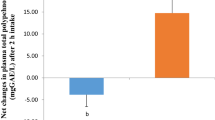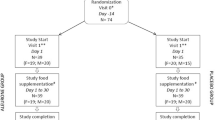Summary
Background
Rye bread contributes an important part of the whole grain intake in the Scandinavian diet. Ferulic acid is the major phenolic compound in rye bran and is an antioxidant in vitro and may, therefore, contribute to cardioprotective effects of whole grain consumption.
Aim of the study
Firstly, to evaluate the bioavailability and potential antioxidative effects in humans of ferulic acid from rye. Secondly, to evaluate urine levels of ferulic acid as a possible biomarker of the ordinary dietary intake of ferulic acid.
Methods
We determined the urinary excretion of ferulic acid in 18 postmenopausal women after a dietary intake of rye bran or an inert wheat bran (control) in a crossover study (2 x 6 weeks with 4 weeks washout). The potential antioxidative effect of the rye bran intervention was investigated by measuring lowdensity lipoprotein (LDL) susceptibility to copper oxidation ex vivo. The subjects ingested rye bran enriched breads equivalent to ∼ 10.2 mg ferulic acid per day.
Results
The urinary excretion of ferulic acid averaged ∼ 4.8 mg per day during intervention with rye bran breads and ∼ 1.9 mg per day on the control breads (P = 0.002). Rye bran intervention had no influence on lag time or propagation rate of the LDL oxidation ex vivo.
Conclusions
The present study demonstrated that ferulic acid from rye bran is bioavailable and that the urinary concentration of ferulic acid reflects the dietary intake of this hydroxycinnamic acid. Within the period of intervention, the elevated ferulic acid did not produce a measurable antioxidative effect on the subjects’ LDL. It is suggested that the determination of ferulic acid in urine is a useful biomarker to assess the intake of ferulic acid from a regular diet.
Similar content being viewed by others
References
Pietinen P, Rimm EB, Korhonen P, Hartman AM, Willett WC, Albanes D, Virtamo J (1996) Intake of dietary fiber and risk of coronary heart disease in a cohort of Finnish men. The Alpha- Tocopherol, Beta-Carotene Cancer Prevention Study. Circulation 94:2720–2727
Jacobs DR Jr, Meyer KA, Kushi LH, Folsom AR (1998) Whole-grain intake may reduce the risk of ischemic heart disease death in postmenopausal women: the Iowa Women’s Health Study. Am J Clin Nutr 68(2):248–257
Liu S, Stampfer MJ, Hu FB, Giovannucci E, Rimm E, Manson JE, Hennekens CH, Willett WC (1999) Whole-grain consumption and risk of coronary heart disease: results from the Nurses’Health Study. Am J Clin Nutr 70:412–419
Slavin JL, Martini MC, Jacobs DR Jr, Marquart L (1999) Plausible mechanisms for the protectiveness of whole grains. Am J Clin Nutr 70(3 Suppl):459S–463S
Danish Food Agency (1996) Dietary habits in Denmark, 1995. The Danish Food Agency, Publ. no. 235, Søborg, DK
Andreasen MF, Landbo A, Christensen LP, Hansen Å, Meyer A (2001) Antioxidant effects of phenolic rye (Secale cereale L.) extracts, monomeric hydroxycinnamates, and ferulic acid dehydrodimers on human low-density lipoproteins. J Agric Food Chem 49(8):4090–4096
Andreasen MF, Christensen LP, Meyer AS, Hansen A (2000) Content of phenolic acids and ferulic acid dehydrodimers in 17 rye (Secale cereale L.) varieties. J Agric Food Chem 48(7): 2837–2842
Graf E (1992) Antioxidant potential of ferulic acid. Free Rad Biol Med 13(4):435–448
Nardini M, D’Aquino M, Tomassi G, Gentili V, Di Felice M, Scaccini C (1995) Inhibition of low-density lipoprotein oxidation by caffeic acid and other hydroxycinnamic acid derivatives. Free Rad Biol Med 19:541–552
Ohta T, Nakano T, Egashira Y, Sanada H (1997) Antioxidant activity of ferulic acid beta-glucuronide in the LDL oxidation system. Biosci Biotechnol Biochem 61:1942–1943
Natella F, Nardini M, Di Felice M, Scaccini C (1999) Benzoic and cinnamic acid derivatives as antioxidants: structure- activity relation. J Agric Food Chem 47(4):1453–1459
Kikuzaki H, Hisamoto M, Hirose K, Akiyama K, Taniguchi H (2002) Antioxidant properties of ferulic acid and its related compounds. J Agric Food Chem 50:2161–2168
Dinis TC, Santosa CL, Almeida LM (2002) The apoprotein is the preferential target for peroxynitrite-induced LDL damage protection by dietary phenolic acids. Free Radic Res 36(5):531–543
Kroon PA, Faulds CB, Ryden P, Robertson JA,Williamson G (1997) Release of covalently bound ferulic acid from fiber in the human colon. J Agric Food Chem 45:661–667
Andreasen MF, Kroon PA, Williamson G, Garcia-Conesa MT (2001) Esterase activity able to hydrolyze dietary antioxidant hydroxycinnamates is distributed along the intestine of mammals. J Agric Food Chem 49(11):5679–5684
Cremin P, Kasim-Karakas S, Waterhouse AL (2001) LC/ES-MS detection of hydroxycinnamates in human plasma and urine. J Agric Food Chem 49(4):1747–1750
Bourne LC, Rice-Evans C (1998) Bioavailability of ferulic acid. Biochem Biophys Res Commun 253(2):222–227
Bourne L, Paganga G, Baxter D, Hughes P, Rice-Evans C (2000) Absorption of ferulic acid from low-alcohol beer. Free Radic Res 32(3):273–280
Kern SM, Bennett RN, Mellon FA, Kroon PA, Garcia-Conesa M-T (2003) Absorption of hydroxycinnamates in humans after high-bran cereal consumption. J Agric Food Chem 51:6050–6055
Azuma K, Ippoushi K, Nakayama M, Ito H, Higashio H, Terao J (2000) Absorption of chlorogenic acid and caffeic acid in rats after oral administration. J Agric Food Chem 48:5496–5500
Andreasen MF, Christensen LP, Meyer AS, Hansen Å (1999) Release of hydroxycinnamic and hydroxybenzoic acids in rye by commercial plant cell wall degrading enzyme preparations. J Sci Food Agric 79:411–413
Lamuela-Raventòs RM, Waterhouse AL (1994) A direct HPLC separation of wine phenolics. AmJ Enol Vitic 45:1–5
Princen HMG, van Poppel G, Vogelezang C, Buytenhek R, Kok FJ (1992) Supplementation with vitamin E but not β-carotene in vivo protects lowdensity lipoprotein from lipid peroxidation in vitro. Arterioscler Thromb 12:554–562
Lowry OH, Rosebrough NJ, Farr AL, Randall RJ (1951) Protein measurement with the Folin reagent. J Biol Chem 193:265–275
Scheek LM, Wiseman SA, Tijburg LB, van Tol A (1995) Dialysis of isolated low density lipoprotein induces a loss of lipophilic antioxidants and increases the susceptibility to oxidation in vitro. Atherosclerosis 117(1):139–144
Esterbauer H, Striegl G, Puhl H, Rotheneder M (1989) Continuous monitoring of in vitro oxidation of human low density lipoprotein. Free Radic Res Com 6:67–75
Altman DG (1999) Practical statistics for medical research. Chapman & Hall/CRC: 467–471, London, p. 611
Adam A, Crespy V, Levrat-Verny M, Leenhardt F, Leuillet M, Demigné C, Rémésy C (2002) The bioavailability of ferulic acid is governed primarily by the food matrix rather than its metabolism in intestine and liver in rats. J Nutr 132:1962–1968
Choudhury R, Srai SK,Debnam E, Rice-Evans CA (1999) Urinary excretion of hydroxycinnamates and flavonoids after oral and intravenous administration. Free Rad Biol Med 27:278–286
Williamson G, Kroon PA, Faulds CB (1998) Hairy plant polysaccharides: a close shave with microbial esterases. Microbiol 144:2011–2023
Virgili F, Pagana G, Bourne L, Rimbach G, Natella F, Rice-Evans C, Packer L (2000) Ferulic acid excretion as a marker of consumption of a French maritime pine (Pinus Maritima) bark extract. Free Rad Biol Med 28(8):1429–1256
Esterbauer H, Gebiki J, Puhl H, Jurgens G (1992) The role of lipid peroxidation and antioxidants in oxidative modification of LDL. Free Rad Biol Med 13:341–390
Anderson KJ, Teuber SS, Gobeille A, Cremin P, Waterhouse AL, Steinberg FM (2001) Walnut polyphenolics inhibit in vitro human plasma and LDL oxidation. J Nutr 131(11):2837–2842
Zhu QY, Huang Y, Tsang D, Chen Z (1999) Regeneration of α-tocopherol in human low-density lipoprotein by green tea catechin. J Agric Food Chem 47:2020–2025
Laughton MJ, Evans PJ, Moroney NA, Hoult JRS, Halliwell B (1991) Inhibition of mammalian 5-lipoxygenase and cyclo- oxygenase by flavonoids and phenolic dietary additives. Relationship to antioxidant activity and to iron ionreducing ability. Biochem Pharmacol 42:1673–1681
Nogata Y, Yoza K, Kusumoto K, Kohyama N, Sekiya K, Ohta H (1996) Screening for inhibitory activity of citrus fruit extracts against platelet cyclooxygenase and lipoxygenase. J Agric Food Chem 44:725–729
Schubert SY, Lansky EP, Neeman I (1999) Antioxidant and eicosanoid enzyme inhibition properties of pomegranate seed oil and fermented juice flavonoids. J Etnopharmacol 66:11–17
Author information
Authors and Affiliations
Corresponding author
Rights and permissions
About this article
Cite this article
Harder, H., Tetens, I., Let, M.B. et al. Rye bran bread intake elevates urinary excretion of ferulic acid in humans, but does not affect the susceptibility of LDL to oxidation ex vivo . Eur J Nutr 43, 230–236 (2004). https://doi.org/10.1007/s00394-004-0463-5
Received:
Accepted:
Published:
Issue Date:
DOI: https://doi.org/10.1007/s00394-004-0463-5




